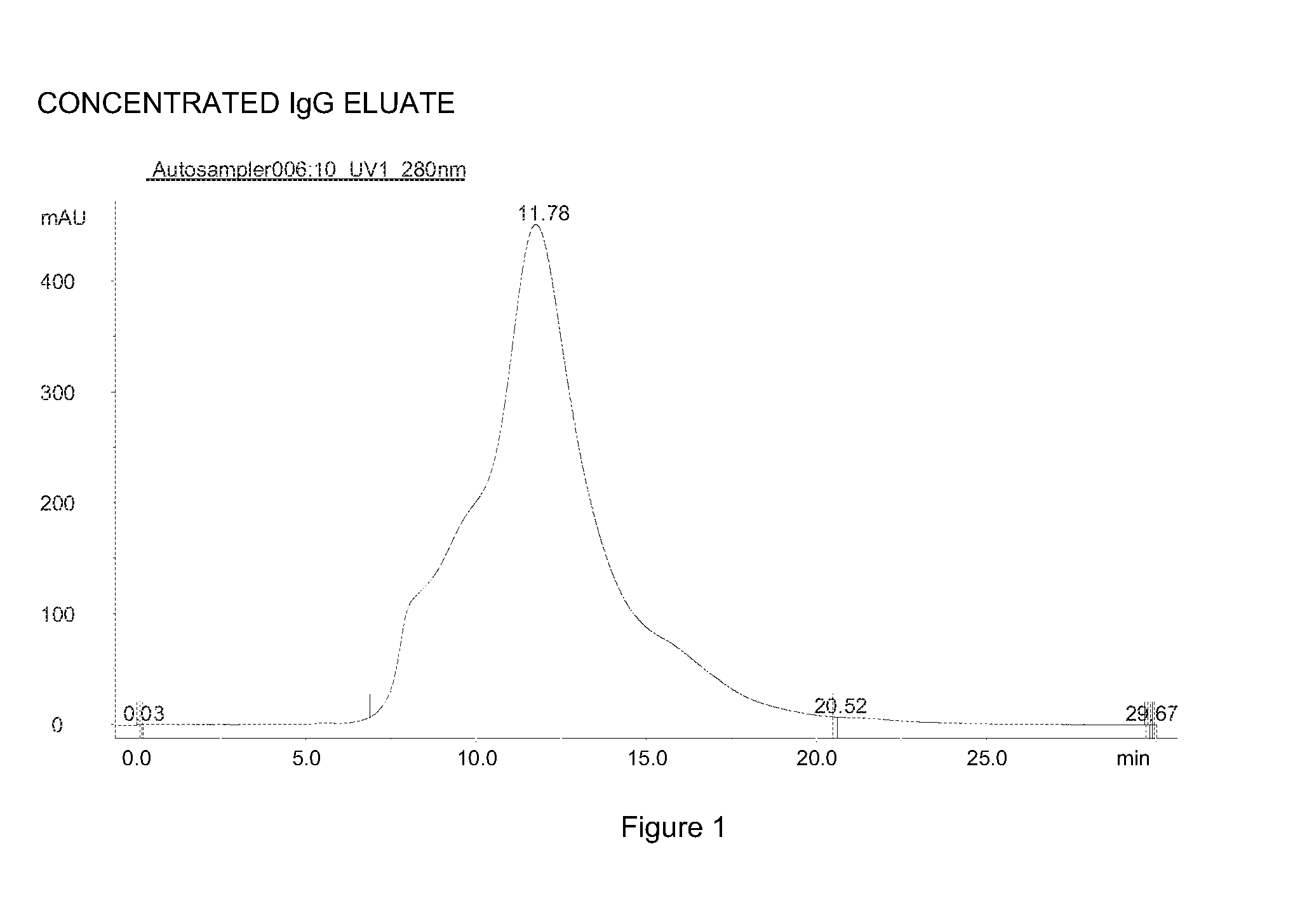Products and methods to prevent infections
a product and technology of products, applied in the field of products and methods to prevent infections, can solve the problems of difficult measurement of colostral igg concentration, increased risk of neonatal feeding, and inability to absorb igg 100% efficiency, so as to improve the health of subjects and increase the resistance to pathogenic infections
- Summary
- Abstract
- Description
- Claims
- Application Information
AI Technical Summary
Benefits of technology
Problems solved by technology
Method used
Image
Examples
example 1
Isolation of Immunoglobulin G from Sweet Whey Utilising Expanded Bed Adsorption
Isolation Procedure
[0404]Non-pasteurised sweet whey was obtained from cheese production at a local Danish dairy.
[0405]3150 L sweet whey was adjusted to 5.0 with hydrochloric acid before being loaded onto an expanded bed adsorption column (Rhobust Flex 45 cm i.d., UpFront Chromatography, Denmark) containing 105 L adsorbent (tungsten carbide—agarose conglomerate beads comprising an anionic mixed mode as IgG binding ligand, bead density=301 kg per L, mean particle size=190 micron, UpFront Chromatography A / S, Denmark). The settled bed height of the adsorbent was 64 cm.
[0406]The sweet whey, which had a conductivity of 6.5 mS / cm was loaded onto the column using a linear flow rate of 9 cm / min.
[0407]All procedures were performed at ambient temperature.
[0408]Following load of the sweet whey to the expanded bed column, the adsorbent was washed by loading 750 L of a washing buffer (10 mM sodium citrate, 0.35 mg / ml c...
example 2
Multimerization of IgG Isolated from Sweet Whey
[0423]The purpose of the following example was to demonstrate the transformation of the mainly monomeric IgG molecules isolated in example 1 into multimeric, covalently assembled, agglomerates comprising several IgG molecules. The Concentrated IgG Eluate described in Example 1 was used as raw material.
Multimerisation Procedure
[0424]All procedures were performed at ambient temperature.
[0425]Three samples of the Concentrated IgG Eluate were adjusted to pH 5.5 using 1M acetic acid.
[0426]Sodium periodate (cat. No.: 30323, Sigma-Aldrich, USA) was added under gentle mixing to the concentrate to reach a concentration of A) 10 mM periodate B) 20 mM periodate and C) 40 mM periodate in three separate samples. The solution was then stored without mixing in the dark for 1 hour followed by adjusting to pH 9.5 using 1 M sodium hydroxide and then left without mixing at room temperature for 24 hours. Hereafter pH was adjusted to pH 7.0 with 1 M hydroch...
example 3
Multimerization of IgG Directly in Colostrum Whey
[0431]The purpose of the following example was to transform the mainly monomeric immunoglobulin molecules naturally present in colostrum into multimeric, covalently assembled, agglomerates comprising several immunoglobulin molecules. Bovine colostrum whey prepared by casein precipitation of crude colostrum was used as raw material.
Multimerisation Procedure
[0432]All procedures were performed at ambient temperature.
[0433]Bovine colostrum was collected from a local Danish farm using only the first 2 days of milking after parturition. Pooled colostrum was adjusted to pH 4.5 with 1 M hydrochloric acid and centrifuged. The clear supernatant was decanted and utilised for the multimerisation procedure.
[0434]Three samples of the colostrum whey were adjusted to pH 5.5 using 1M acetic acid.
[0435]Sodium periodate (cat. No.: 30323, Sigma-Aldrich, USA) was added under gentle mixing to the colostrum samples to reach a concentration of A) 0 mM period...
PUM
| Property | Measurement | Unit |
|---|---|---|
| concentration | aaaaa | aaaaa |
| concentration | aaaaa | aaaaa |
| pH | aaaaa | aaaaa |
Abstract
Description
Claims
Application Information
 Login to View More
Login to View More - R&D
- Intellectual Property
- Life Sciences
- Materials
- Tech Scout
- Unparalleled Data Quality
- Higher Quality Content
- 60% Fewer Hallucinations
Browse by: Latest US Patents, China's latest patents, Technical Efficacy Thesaurus, Application Domain, Technology Topic, Popular Technical Reports.
© 2025 PatSnap. All rights reserved.Legal|Privacy policy|Modern Slavery Act Transparency Statement|Sitemap|About US| Contact US: help@patsnap.com



